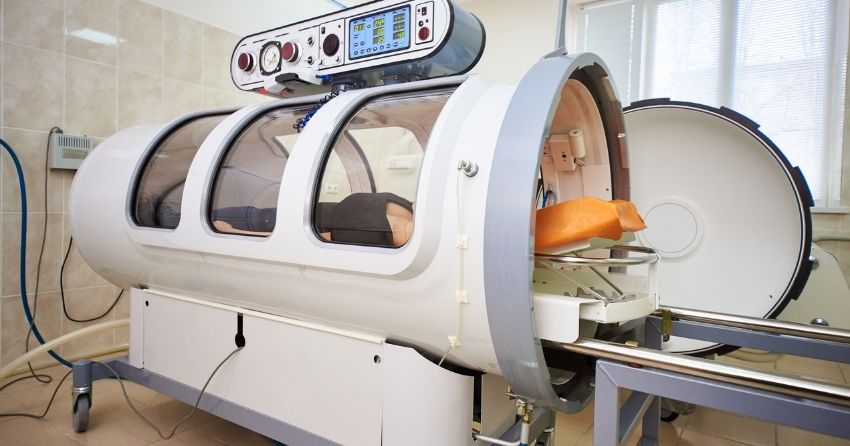High-Pressure Oxygen Therapy Breathes Life into Human Cells

From the myths about the fountain of youth and the philosopher’s stone to the modern-day stories of Dr. Who and Harry Potter, the prevention of aging has captured the human imagination for millennia. Modern science has shown that, as we age, the ability of our cells to grow and replicate to replace deteriorating or damaged counterparts becomes increasingly limited. This process of growth and replication arrest (senescence) is closely linked to the shortening of caps at the tips of chromosomes called telomeres that protect our genetic blueprints.
Several links between telomere length and lifestyle modifications have been observed. This has led to several interventional studies on diet and supplements (such as omega-3 and walnuts), physical activity, stress management, and social support. Now, new research shows that the secret may lie not in an elixir or potion but in a chamber filled with pressurized oxygen. For the first time in humans, a team of scientists from Israel has shown that repeated daily hyperbaric oxygen therapy sessions can increase the telomere length of immune cells and decrease the number of cells that can no longer grow and replicate.
"Since telomere shortening is considered the 'Holy Grail' of the biology of aging, many pharmacological and environmental interventions are being extensively explored in the hopes of enabling telomere elongation,” said Dr. Shai Efrati, M.D., the research group leader. "After dedicating our hyperbaric oxygen therapy research to exploring its impact on the areas of brain functionality and age-related cognitive decline, we have now uncovered for the first time in humans hyperbaric oxygen therapy’s biological effects at the cellular level in healthy aging adults.”
Reactive oxygen species can take the youth out of cells
While many genetic and environmental factors are linked with telomere shortening, the most common suggested mechanism is oxidative stress. This happens when there is an imbalance between reactive oxygen species—unstable molecules that contain oxygen and easily react with other molecules in a cell to cause damage—and a biological system's ability to readily detoxify them.
The DNA that makes up telomeres is highly sensitive to oxidative damage, which can induce telomere shortening and dysfunction. The main causes for oxidative stress are obesity, diets high in fat, sugar, and processed foods, exposure to radiation, smoking cigarettes or other tobacco products, alcohol consumption, certain medications, pollution, and exposure to pesticides or industrial chemicals.

High-pressure oxygen pumps out indicators of cellular aging
Thirty-five healthy, independently living adults, aged 64 and older, were enrolled to receive 60 daily hyperbaric oxygen therapy exposures. Whole blood samples were collected at baseline, at the 30th and 60th session, and 1-2 weeks following the last hyperbaric oxygen therapy session. The research team then measured the length of telomeres and senescence in different types of immune cells.
What they saw was that the telomeres of these cells increased significantly by over 20% following hyperbaric oxygen therapy. The most significant change was noticed in B cells, a type of white blood cell that secretes antibodies, which increased at the 30th session, 60th session, and following hyperbaric oxygen therapy. They also observed a significant decrease in the number of senescent cytotoxic T cells, immune cells that defend the body by directly killing other cells, after hyperbaric oxygen therapy.
Can aging be reversed in an oxygen chamber?
So, it seems that hyperbaric oxygen therapy may induce anti-aging effects, including increasing telomere length and clearance of senescent cells in the aging populations. “The significant improvement of telomere length shown during and after these unique hyperbaric oxygen therapy protocols provides the scientific community with a new foundation of understanding that aging can, indeed, be targeted and reversed at the basic cellular-biological level," said Dr. Efrati.
"Until now, interventions such as lifestyle modifications and intense exercise were shown to have some inhibition effect on the expected telomere length shortening. However, what is remarkable to note in our study, is that in just three months of hyperbaric oxygen therapy, we were able to achieve such significant telomere elongation – at rates far beyond any of the current available interventions or lifestyle modifications," explained Dr. Hadanny, an author of the research article. "With this pioneering study, we have opened a door for further research on the prolonged cellular impact of hyperbaric oxygen therapy to reverse the aging process."
Sucking all the oxygen out of the room
This begs the question, “Should you start spending time in a hyperbaric oxygen chamber?” The study has some pretty important faults. The study’s limited sample size—only 35 people were studied—and short length are of real concern. More work is needed to see if the effect seen on telomere length and senescence in immune cells in a larger population for a longer period of time. Also, the researchers only really looked at one family of cell types—immune cells. It’s unclear if hyperbaric oxygen treatment actually removed about a third of senescent cells in the wider human body in tissues where aging is most detrimental like from nerves and muscle. More research is needed to see how widespread and effective hyperbaric oxygen therapy is on aging in humans. But don’t hold your breath.
References:
Hachmo Y, Hadanny A, Abu Hamed R, et al. Hyperbaric oxygen therapy increases telomere length and decreases immunosenescence in isolated blood cells: a prospective trial. Aging (Albany NY). 2020;12(22):22445-22456. doi:10.18632/aging.202188







